Fly “Trekker” Helmet Review
The Fly Trekker Dual Sport helmet looks the part and it feels solid and well made.
The helmet has a comfortable fit and the price is reasonable.
But — the Trekker has three issues, one of which may be a deal-killer. Read on…
Fly Racing may not be a familiar name to street riders or cruiser owners.
But off-road and motocross fans know the brand, which sponsors many off-road racers.
Fly Racing now also offers a line of street clothing styled for the enduro or adventure touring or dual-sport crowd and they even have a few full-face street helmet designs in the mix.
The Fly Trekker helmet is their dual-sport entry and if the shape looks familiar, well, you have a good memory.
The Trekker does look very similar to the AFX FX-39 DS helmet (review) which was reviewed on webBikeWorld not long ago.
In fact, it wouldn’t surprise me at all to learn that both helmets were made in the same factory. Which might lead you to believe that there isn’t much difference between the two, right? Wrong.
Although the helmets may look similar, the Fly Racing Trekker differs in three ways. Four actually if you count the internal shape.
Wait — make that five if you count the warranty.
So what are all these differences? Let’s take a look at the Fly Trekker and learn all about it…
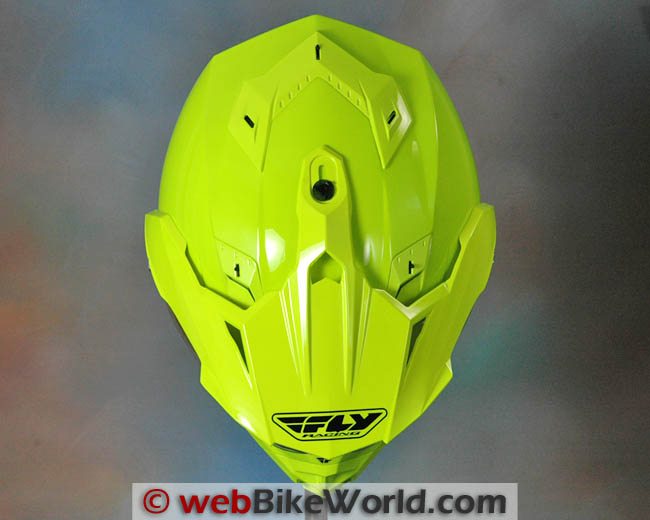
Where to Buy Fly Trekker Helmet.
Check Reviews & Prices on Amazon Check Reviews & Prices On RevZillaSee More Motorcycle Helmets, Motorcycle Visor, Motorcycle Intercom
The Fly Trekker: Paint, Graphics and Overall Quality
The Fly Trekker has the same angular good looks as the AFX FX-39 DS, although the shell on both of these helmets seems a bit out of proportion to the internal size.
This means that from certain angles, the helmet can look oversized on just about any head.
But overall, it’s a nice look in the modern dual-sport idiom. That is, if you’re into the dual-sport/enduro/adventure-touring thing.
Pure street/sport riders will probably blanch at this helmet style, not to mention what happens to your stomach when you look at the lime yellow high-viz color on our Trekker!
But hey — that’s the whole idea of this color, right? Stand out in the crowd. And for even more of the same, try the Fly Racing “Terra Trek” jacket in the same lime yellow high-viz. Yoiks! If they don’t see you coming in that outfit, all hope is lost.
[UPDATE: The Trekker is available in solid colors (silver, black, matte black and white in addition to the high-viz yellow shown here). The vent covers on the Fly Trekker are painted to match.
The reason the AFX FX-39 DS has black colored vents is because that helmet is available in graphic patterns, such as the MARPAT camouflage of the helmet we reviewed.
Matching the graphics on all of the vent covers would have raised the cost of the AFX helmet, so they went with black instead, to match any graphic. This is the tradeoff for having graphics available.]
The overall quality of the Trekker is excellent.
The helmet feels solid and well made and the paint is very good, with only a few tiny dimples and pimples and some semi-rough edges around a few of the plastic pieces. This is to be expected in the sub-$150 list (~$125 street) price range though.
The Trekker is labeled as meeting both DOT and ECE safety standards and this might be what helps to give it an overall feeling of solidity, just like we found on the 2011 AFX helmet lineup, which now also meets both standards.
I’ll jump ahead of myself here, but the liner material on the Trekker feels a bit rougher than the AFX FX-39 DS however, although I personally like the fit of the Trekker better.
But overall, the two helmets seem about the same in terms of overall quality and construction.
The face shield on this particular sample also seems to have more distortion than the AFX FX-39 DS I tried though. It’s almost like Fly Racing is using the supplier that AFX used previously, and we had some complaints about face shield quality back then.
More on this in the Face Shield section below.
But this may be just a one-off problem, although it’s important for potential dual-sport helmet owners to realize that making a face shield to fit this type of helmet shape can be difficult, due to the compound curves and large surface area.
So my advice is to make sure you try these helmets before you buy them and carefully check the quality of the face shield, while wearing your eyeglasses also if you wear them.
Score: I’ll give the Fly Trekker an “Excellent” rating for paint, design and overall quality, although the face shield on my example gets a “Neutral” rating from me. See the Summary Table at the bottom of the page for a description of our rating system.
Where to Buy Fly Trekker Helmet.
Check Reviews & Prices on Amazon Check Reviews & Prices On RevZillaSee More Motorcycle Helmets, Motorcycle Visor, Motorcycle Intercom
Fly Trekker Helmet Fit, Internal Shape and Liner
This Trekker that I purchased is a size large, and I think it fits exactly to size as I expected, unlike the AFX FX-39 DS, which seems to run at least one size big.
Also, the internal shape of the Fly Racing Trekker is rounder than the FX-39 DS, which has a more neutral shape. So I’m going to call the Trekker a “Slight Round” in the webBikeWorld helmet shape classification scheme.
In fact, I think the Trekker feels very similar to the Arai RX-Q (review), both in terms of fit and liner comfort.
This is neither a plus nor a minus, just something to note and which helmet you choose may depend on your preference.
I couldn’t find a size chart on the Fly Racing website, but the retailers list a size large Trekker as fitting about a 59.0 to 60.0 cm head which I think is about right.
I also don’t know the breakdown of the shell sizes used by Fly Racing for the Trekker but I’d guess they run the same as the AFX FX-39 DS, with two shells to cover the range of XS to XXL with the break coming at size L.
The Trekker shell is made from polycarbonate, by the way and Fly Racing claims the Trekker has a dual-density EPS liner.
The liner material used in the Trekker feels a bit scratchy to me, rougher than the material used in the FX-39 DS. This is especially noticeable in hot weather and we’re now deep into summer, so it makes a difference. However, the thickness of the padding is good.
The ear pockets of the Trekker seem identical to the design used on the FX-39 DS. They are roomy and unlined at the shell but with a plastic section fitted, which should act as a very good anchor for gluing in some Velcro speaker holders.
My ear-less sunglasses fit in the helmet with no problems.
But something else I noticed is that the face shield distortion seems much worse for wearers of progressive lenses.
That is, eyeglass lenses that have a continuous transition from distance to close range. Why this might be is unknown, but again, it’s something to evaluate when buying the helmet.

More information on helmet fit can be found in the webBikeWorld Motorcycle Helmet FAQ page, along with the chart that lists the helmet weights of webBikeWorld reviewed helmets and also by shape on the webBikeWorld Motorcycle Helmet Shapes page.
Score: I’ll give the Fly Trekker a “Very Good” rating for shape comfort and padding but the liner material isn’t as soft as I’d like.
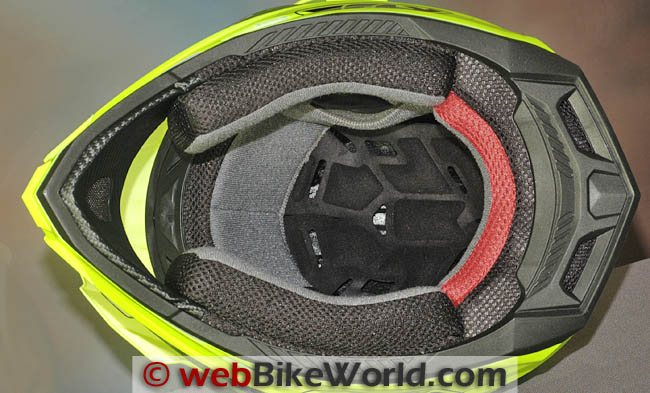
Fly Trekker Face Shield, Eye Port and Visibility
Put one of these on after wearing a typical full-face helmet and you’ll be amazed at how much of the road you didn’t see before.
The Trekker is no exception; it provides excellent visibility in all directions, although the slightly protruding chin bar does remain in the rider’s peripheral vision towards the bottom.
I have mixed feelings about the face shield on this particular helmet though, as I mentioned earlier. It has a slight waviness and irregularities in some portions of the surface.
Looking at the curvature, it is very sharply curved towards the center compared to the face shield of a full-face helmet, then the curve sort of blends out into two angles on either side.
These angled sections of polycarbonate are in front of the eyes, so what happens is that the rider is looking through the clear face shield material not at the perpendicular but at an angle, slight as it may be.
There is something about the quality of the polycarbonate in this particular lens that causes some distortion for me and for another rider who wears progressive lens eyeglasses.
The issue here is that the manufacturers need to understand that face shield quality in a helmet of this type must be outstanding, due to the constraints and intricacies of the design required by the shape of the dual-sport helmet.
So extra attention must be paid to this area, even if it adds some cost to the helmet, in my opinion.
For some reason, the face shield on the AFX FX-39 DS we reviewed had better quality than the shield used by Fly Racing on this Trekker.
Also, the face shield on this Trekker has only two detents; half open and full open. There is no small defogging position, despite Fly Racing’s claim that the Trekker has a “multi-position, ratcheting face shield”.
Well, I guess it isn’t a lie, because two positions are “multi”, right?
For all I know, both the AFX and Fly Racing dual-sport helmets may be (and probably are) built in the same factory, using the same face shield or face shield supplier.
If so, then the quality varies, because the Trekker version just isn’t up to snuff, at least on this particular sample.
The face shield is marked as meeting EC standards but not the VESC-8 standard used in the U.S. The face shield on this helmet measures 1.95 mm to 2.05 mm thick.
It also has two lift tabs in the front, which are handy, but there is some twisting of the face shield as it is lifted or lowered, probably due to the resistance in the rotating mechanism.
The full-length eye port gasket seals against the back of the face shield tightly enough to prevent water from entering along the top. It feels like a weaker seal along the bottom, but overall it seals well and there are no leakage problems.

Score: I’ll give the Fly Trekker an “Excellent” rating for the overall quality and operation of the face shield and the sealing of the eye port gasket. I’ll give it a “Neutral” for some quality problems with regards to clarity and optical quality.
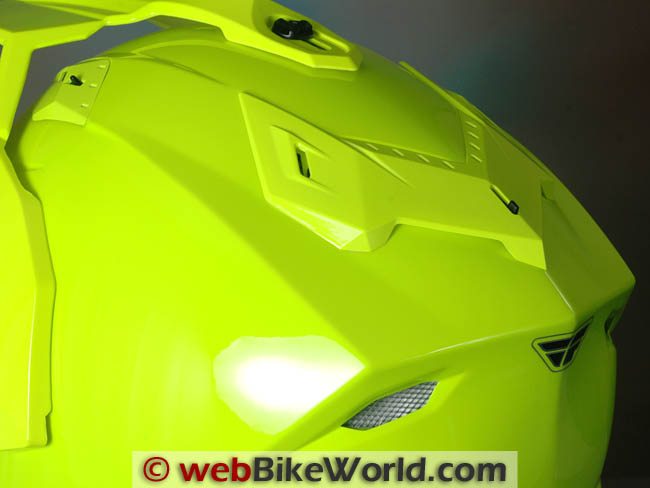
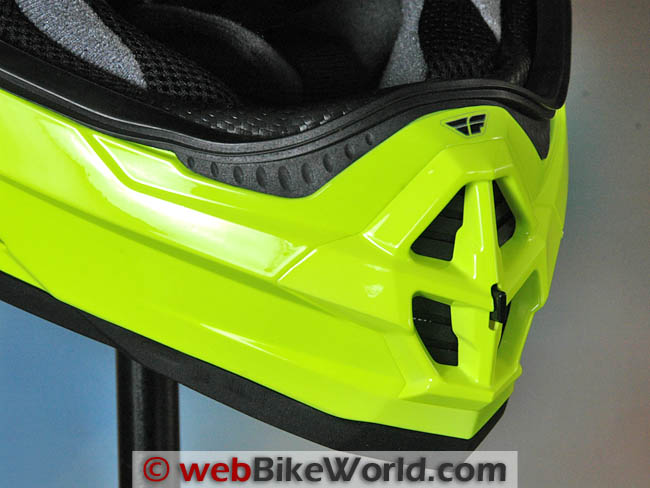
Fly Trekker Ventilation and Air Flow
Fly Racing claims 8 intake vents and 8 exhaust vents on the Trekker.
If so, I don’t know where they are; I count two on top and a chin vent for a total of 3. Maybe add in the vent along the bottom of each side of the helmet to make two more?
I bet they’re counting the chin vent, which has a plastic insert dividing it into four sections as four separate vents. Uh-uh, sorry.
Same miscount for the exhaust vents. There are four on the back and two under the upper rear vent assembly. That makes six, not eight.
In any case, ventilation is good and probably a bit better than average, but like any dual-sport helmet I’ve tried, it’s hard to tell. You’ll get a lot of air flowing in from under the chin bar whether you want it or not, due to the chin bar design.
The top vents have a small narrow slit opening and it’s difficult to tell whether they’re doing anything or not. Looking inside under the liner, there are air vent holes through the EPS but they are somewhat blocked by the fabric liner.
As for the exhaust vents, well, who knows?

Score: I’ll give the ventilation system of the Fly Trekker an “Excellent” rating.
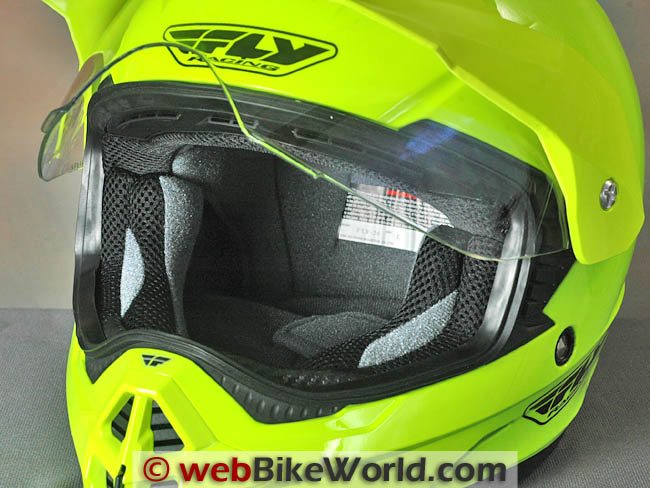
Where to Buy Fly Trekker Helmet.
Check Reviews & Prices on Amazon Check Reviews & Prices On RevZillaSee More Motorcycle Helmets, Motorcycle Visor, Motorcycle Intercom
Fly Trekker Sound Levels
The Trekker seems to control noise levels fairly well and I don’t think it’s much different than the FX-39 DS in this regard.
The internal padding and liner material feels different, probably accounting for some variation between the two helmets.
But overall, and for a helmet of this type, I think the Trekker is slightly quieter than average and less noisy than some full-face helmets I’ve worn.
This has a lot to do with the fit of the helmet also and the Trekker is nice and comfy on my head, surrounding me inside, which probably helps to reduce noise levels also.

Note that our helmet evaluations are a combined effort of several riders over time on different types of motorcycles with and without windscreens.
Evaluators wear correctly fitted, high quality ear plugs (even when evaluating motorcycle intercom systems).
Always protect your hearing when riding a motorcycle. See the wBW Earplug Reviews for more information on choosing and wearing earplugs.
Note also that perceived noise levels will vary, depending on the individual.
Noise can be caused by many factors, including helmet fit, the type of motorcycle and windscreen, wind speed and direction and even the rider’s clothing.
For more information on helmet noise, visit the wBW Motorcycle Helmet Noise page.
Score: I’ll give the Fly Trekker an “Excellent” rating for slightly better than average noise control.
Helmet Weight
This Fly Trekker in size large weighs in at 1795 grams, a statistical dead heat with the AFX FX-39 DS (Dual Sport) in size large at 1784 grams.
This is a bit on the heavy side, no doubt about it, but the helmet has pretty good balance except for some abnormal lift noticed, coming from the design of the peak no doubt.
Overall, the weight is really only mostly noticed when handling the helmet and not when it is on my head.
For comparison purposes, other helmets in this weight range we have reviewed include the Shoei Multitec (review) flip-up (XL) at 1786 grams and the Vega Summit 3.0 (review) at 1789 grams in size large.
Also the Vemar VTXE (review) (XL) at 1790 grams; the AFX FX-87X (review) flip-up (XL) at 1799 grams; the HJC IS-Max (review) (L/XL) at 1803 grams and the Bell Revolver (review) flip-up in size L at 1808 grams.
Note also that all of the helmets reviewed on webBikeWorld have been weighed and the weights are available on the wBW Motorcycle Helmet Weights page, along with a chart that lists the helmets by weight and shape on the wBW Motorcycle Helmet Shapes page.
Score: I’ll give the Fly Trekker a “Very Good” rating for its acceptable weight for this type of helmet and its good balance.
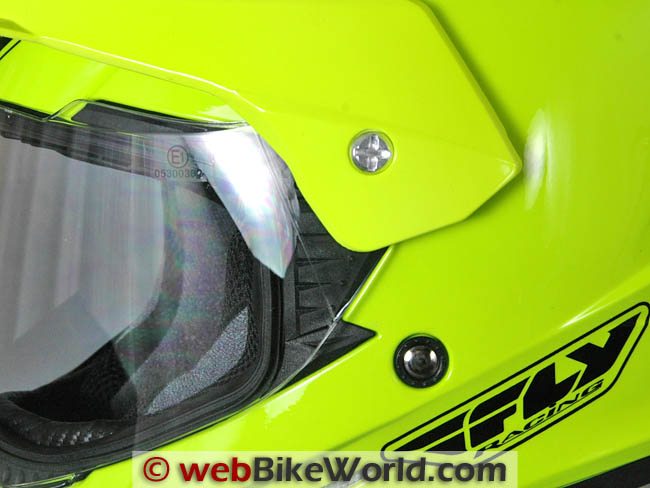
Miscellaneous
The peak design on the Trekker may be the same as the FX-39 DS for all I know.
But for some reason, I experience more lift wearing the Trekker than on any other dual-sport helmets I’ve worn. I tried adjusting the peak angle but it doesn’t seem to make a difference.
The helmet is designed to be worn when you’re riding a dual-sport motorcycle, like the Suzuki DR650 (blog) or BMW R 1200 GS (info).
These are “sit up and beg” riding positions, not leaned-over sportbike riding positions, so it’s important that the helmet does not feel like it is being pulled off the head.
If I tilt me head slightly downwards when riding, the effect is diminished, but overall this is a problem and one that may be the real deal-killer of the Trekker. I’d be interesting in hearing from other Trekker owners about this issue.
The AFX FX-39 DS comes with the side cover conversion kit that allows the peak to be removed so the helmet can be worn as a sort-of full-face (which looks rather…odd). The side covers are installed to hold the clear face shield on the helmet.
The conversion kit for the Fly Trekker is an optional accessory.
Warranty?
One big difference between the AFX FX-39 DS — indeed, between all AFX helmets and the Fly Trekker — is the warranty.
There is no warranty listed on the Trekker box, in the owner’s manual, on the protective strip that was on the face shield, on the Fly Racing website or on the retailers’ websites.
The helmet must have a warranty (one would hope) but if it does, I can’t find it.
On the other hand, AFX helmets have a five-year warranty, which is, in effect, a “lifetime” warranty because the expected life span of the helmet is five years.
AFX also keeps parts “for every model we have ever sold for 10 years. After our distributor stops stocking parts in the 5th year, the replacement parts are offered at no charge for dealers and consumers”.
In addition, AFX will replace your helmet for free if it was damaged in an accident.
Besides our sampling differences in the face shield quality and liner material comfort (and internal shape), this is a major difference in these two helmets and for my money, it definitely tips the scales for the AFX.
One advantage in the Trekker’s favor is its more comfortable double D-ring chin strap that also has a normal length spare end and a plastic button keeper.
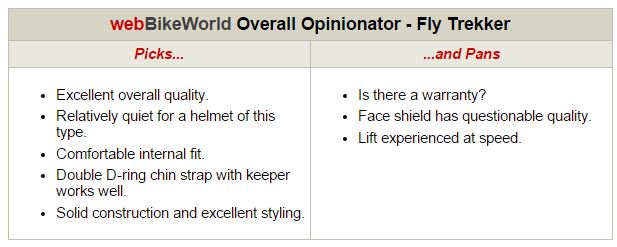
Conclusion
I’d like to like the Fly Trekker; it has nice styling, it fits my head shape very nicely, it’s solidly built and the eye-searing lime yellow high-viz color may be a safety factor.
But a few things need tidying up: the face shield quality on this particular sample is questionable. The face shield should also have more than two detents and include a small first defogging position.
And for some reason, this helmet seems to have more lift than any other dual-sport helmet I’ve tried, despite the near-perfect internal fit and its match to my head shape.
And if the helmet has a warranty — which I assume it does — Fly Racing should print it in the owner’s manual and let the retailers know about it…
Bottom line? It’s obvious to me. As much as I like the Trekker, the very similar AFX FX-39 DS gets my money in this shootout.
| wBW Product Review: Fly Trekker Helmet | |
|---|---|
| Manufacturer: Fly Racing | List Price: $139.95 – $149.95. Other Sources: Fly Trekker Helmet at Amazon.com |
| Colors: Black, Matte Black, Silver, White, High-Viz Yellow. | Made In: Taiwan |
| Sizes: XS-2XL Shell Sizes: Unknown | Review Date: July 2011 |
|
Rating Scale is subjective: Unacceptable, Poor, Neutral, Very Good, Excellent, Outstanding.
|
|
Where to Buy Fly Trekker Helmet.
Check Reviews & Prices on Amazon Check Reviews & Prices On RevZillaSee More Motorcycle Helmets, Motorcycle Visor, Motorcycle Intercom
Owner Comments and Feedback
See details on submitting comments.
From “S.” (June 2013): “I noticed when I rode my ST1100 that my helmet (Shoei RF-1000 (review)) was actually quieter and less vibratory when the shield was up.
Thinking the airflow was being helped by said up visor, I finally bought a lime Trekker to test the theory.
Though the lining was a little scratchy, it fit my melon head in a XL size. First trip was a revelation….no vibration and much less noise.
A later ride without ear plugs revealed little wind rush noise and a lot more tire/road/engine noise than I was used to. Even tilting my head back, the visor didn’t catch wind. Amazing!
I modified the shield for an additional slightly open notch and am really happy. BTW, in trying on several sizes, I noticed two distinctly different shield shapes…the newer shape is stepped at the bottom to allow a more curved rather than pinched shape.
Seems ok optically to me. I’m quite pleased.”
From “J.S.” (August 2012): “I own a Fly Trekker and I agree with the review, especially the comments regarding the shield and visor.
I ride a KLR 650 with a tall windshield, and I occasionally ride a Yamaha XT225 with no windshield. My first experience wearing the helmet was on the XT225.
Due to the visor catching so much air at highway speeds, the helmet constantly moved around on my head bumping my glasses up onto my forehead. I had to take my glasses off to ride safely.
The other issue is that the visor is positioned so that it scoops air from below and pulls one’s head back making it intolerable for any distance.
There is an adjustment slot on the top mounting point of the visor that allows the wearer to adjust the visor’s angle of attack, but it is too limited to be able to move the visor far enough forward to create any down force.
I drilled a ¼” hole in the visor behind the adjustment slot to allow further adjustment. It helped prevent lifting, but the movement from turbulence is still unbearable when wearing glasses. Eventually I removed the visor and it’s now usable.
The other problem with the helmet is the distortion in the shield. One can get used to it, but who would want to?
Overall I like the helmet’s fit and appearance, but the visor and shield are a big disappointment. If I could do it over, I wouldn’t buy it and instead save up some more money for a better engineered helmet.”
From “S.H.K.” (April 2012): “I have the Fly Trekker – Hi-Vis Yellow, XXL. I’ve been running it about 4 months now. I ride pretty much daily — rain, cold, sunny, warm, it don’t matter. I prefer to be on my KLR to my truck.
I changed the peak from the Hi-Vis to flat black. Overall, I love the lid (Tech support at Fly could not be better!). I have had no problems. But, they helped me get a flat black peak. It’s hard to find replacement parts.
I wanted to try the Flat black peak to see if it helped with bright sun. It didn’t. The peak is pointed. So, the sun comes in around the edges. It also does not drop down far enough to offer any shade.
They need to square off the front and bring down the edges for better shade. The peak needs more R&D. I am working modifying mine to meet my needs.
I have a 2XL bucket and a 3XL “melon” head. So, it’s a little tight for me. But, it’s not too bad. The cheek pads interfere with my glasses. The glasses ear pieces are right at the top of the pads.
On rough rides, the pads keep pushing my glasses up.
The shield is good. There is no distortion on mine. But, there are only two detents: all the way open and half way open. On cold, damp mornings, I fight between closed and half way open to keep fogging down.
It desperately needs a detent that is about 1/2 inch open.
I wish I could get a rose colored shield. For that matter, I wish I could find a replacement shield in stock anywhere. Vents are fair. You get lots of wind under the chin. I wear a bandanna in the winter to help with the cold wind.
The reality is I can’t tell when the chin vent is open or closed. It’s the same with the other vents. I can’t tell a difference with them open or closed.
For the money, this is an awesome helmet. I would (and will) buy it again. Unless something better comes along, this is the best on the market to me.”
From “J.O.” (January 2012): “Just got my Trekker the other day and have ridden with it twice. Very good fitting helmet, snug and comfortable. Light weight, looks cool, I like it very much.
The vents all close off, especially in the front which is nice because it keeps the cold air out. Love having the shield, I don’t have to wear goggles anymore and the wide viewing angle plus not having goggles is a 100% improvement in peripheral vision.
The visor is designed to allow air coming in to vent and not lift your head and the two days I have ridden we’ve had high winds and it does lift a little bit, but it is significantly less than my old Arai moto helmet.
The trade-off is worth it for sure. Significantly quieter than my old Arai as well.
Distortion in the shield? Hardly noticeable and I’d rather have that and be able to see more out the sides than wear goggles again.
As for protection and reliability, I don’t really want to have to test that but if that happens, I’ll come back and comment on it…
As for these guys talking about the visor causing lifting at high speeds and excessive noise….if you want a quiet helmet that won’t lift at 180mph, get a space helmet and a crotch rocket.
As far as I’m concerned, a great helmet at a killer price, worth every penny, 5 stars from me!!”
From “N.E.” (July 2011): “I have been using this helmet for about a month now. Like the other commenter, I have no problems with visual distortion (and I have varifocals).
The only issue I have is that the strap is slightly harder to put on than my other helmet – but I’m perfectly comfortable when it is on. I have not noticed any lifting (at c 110 KMh). I’m very happy with the helmet.”
From “C.E.” (July 2011): “My new Fly Trekker helmet is a very nice helmet, looks cool, and is cool. I use it on my KLR650 with standard factory windshield and no hand brush guards.
I use earplugs, so it is very quiet for this type of helmet. I like the shape for the summer, not so confining, more nose and chin space. For the price, I think it would be hard to beat.
Mine is the Hi-Viz yellow. Lots of people have commented on that they can see me from far far away. That is the point and I think Hi-Viz is the new black. Mine is XXL and fits perfect.
I have a Shoei Multitec and a Arai Corsair-V in the same size and seem to fit the same.
As far as the face shield, mine is perfect. I can’t see any distortion, can’t even tell it’s there. We’ll see how she holds up to scratching. I bought the quick release for it, the AFX is supposed to have one already.
The AFX is cheaper, but I don’t like the vents are all painted black, were the Trekker is all the same paint color. The only thing is that someone commented on the paint fading. I hope that is not the case because Fly has offered us a great helmet.”

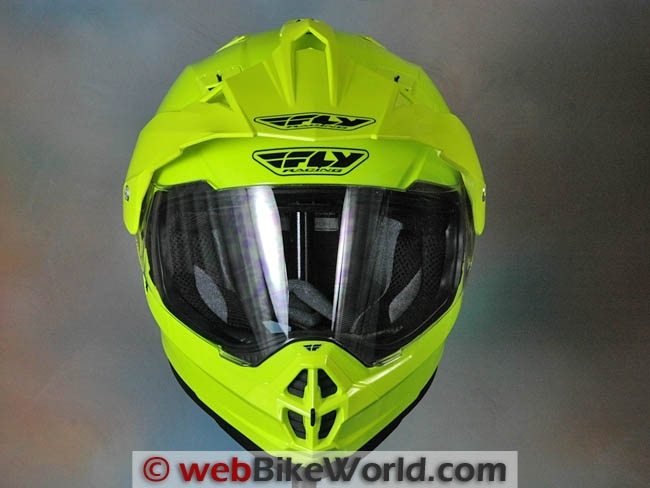
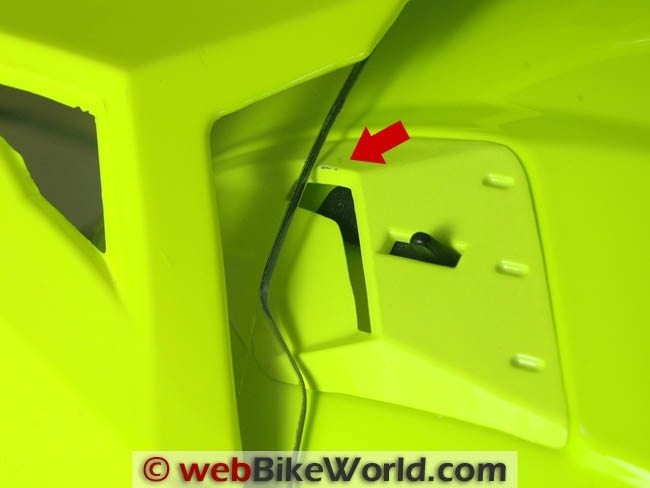
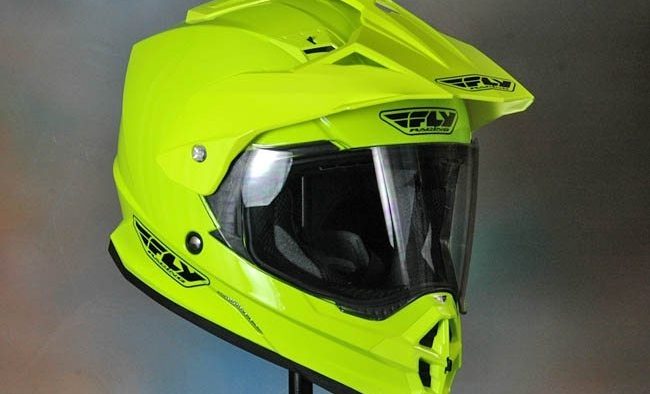

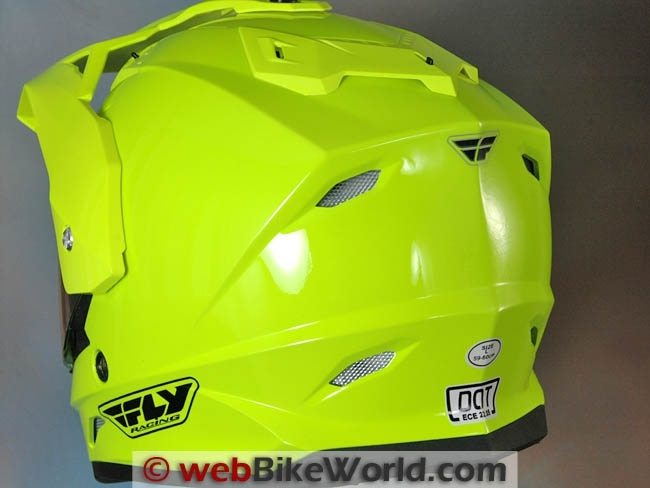
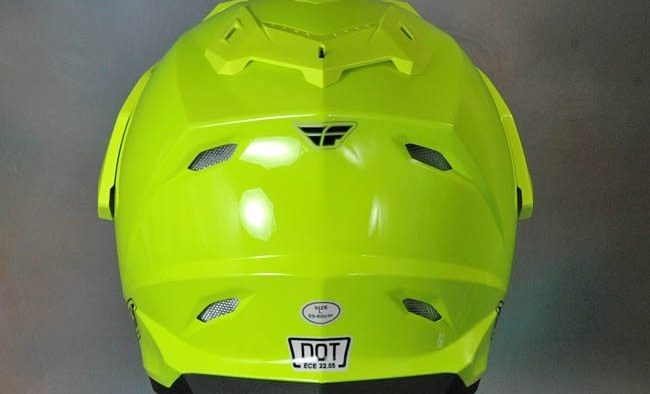


No Comment